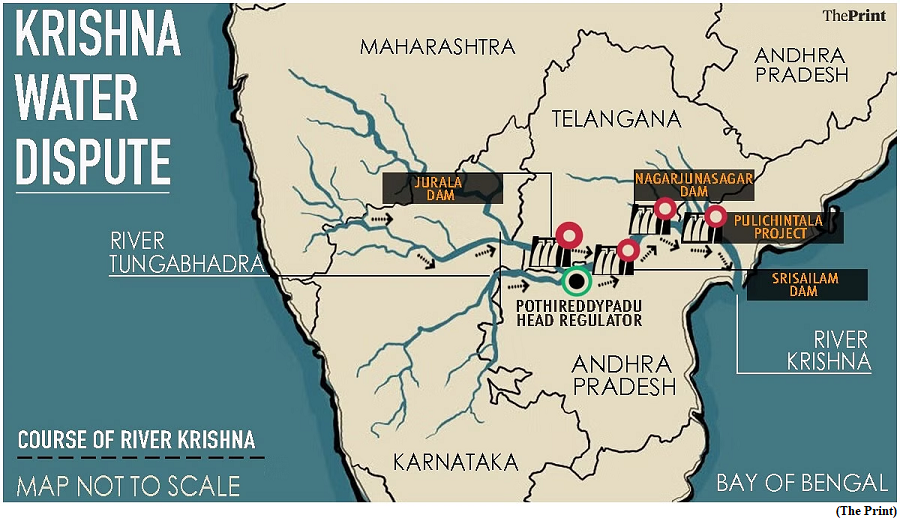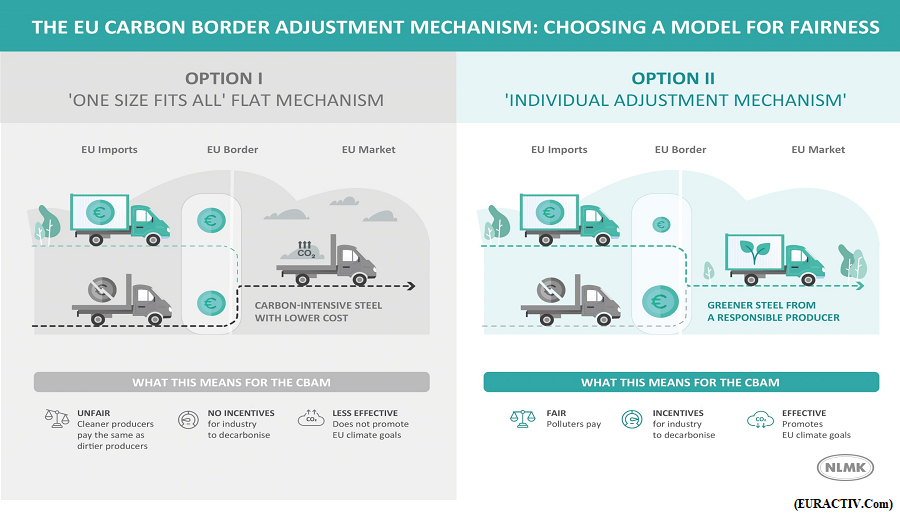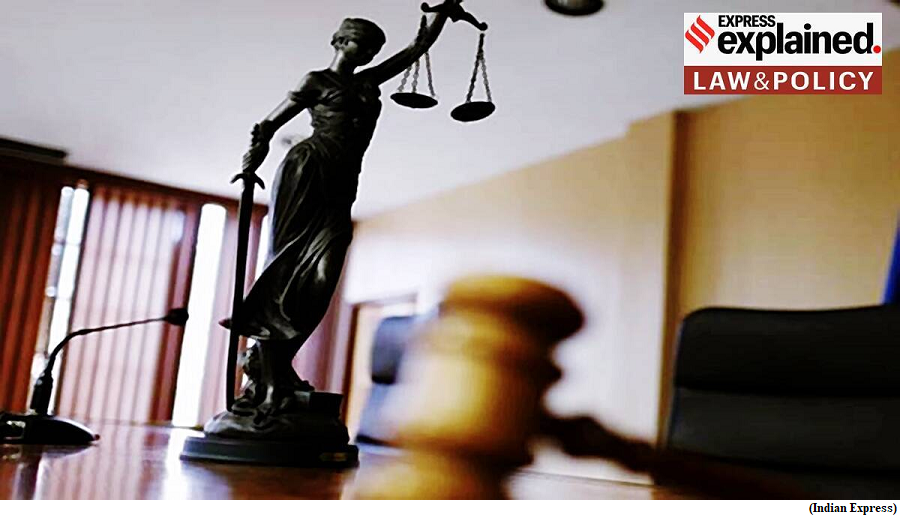CJI condemns ‘forum shopping’ (GS Paper 2, Judiciary)

Why in news?
- The Chief Justice of India (CJI) DY Chandrachud on Friday said that he will not permit 'forum shopping'.
- The CJI made this remark to a litigant appearing before him, who sought a hearing, however, he (the litigant) mentioned the same case a day ago before Justice KM Joseph.
What is forum shopping?
- According to a Supreme Court judgment, dated March 22, 2022, the term 'forum shopping' has not been rendered an exclusive definition in any Indian statute.
- The apex court cited Merriam Webster dictionary and said, ‘The practice of choosing the court in which to bring an action from among those courts that could properly exercise jurisdiction based on the determination of which court is likely to provide the most favourable outcome’.
- The SC further stated that a classic example of 'forum shopping' is when a litigant approaches one court but does not get desired relief and then approaches another court to obtain relief in the same matter.
- As part of their litigation strategy, the lawyers think about which would be the appropriate forum to approach. For Instance, a litigant can directly approach the top court instead of the High Court through the route of Public Interest Litigation (PIL) in order to grab more eyeballs for the issue.
Global practice:
- The practice of forum shopping has also been criticised by the US and UK courts and has been termed as something that needs to be avoided or prohibited.
- However, most common law countries use the ''forum non-conveniens” principle to prevent forum shopping. It gives the court discretionary powers to refuse to exercise its jurisdiction over a matter where another court, or forum, may more conveniently hear a case.
- The Supreme Court in its 1988 ruling in Chetak Construction Ltd. vs. Om Prakash said, “A litigant cannot be permitted a choice of the forum,” and that every attempt at forum shopping “must be crushed with a heavy hand.
Supreme Court's view:
- According to the court's judgment, 'forum shopping' has been termed a disreputable practice by the courts and has no sanction and paramountcy in law.
- In the judgment, the court highlighted that one of the respondents filed three complaints, two in Delhi and one in Kolkata. Looking at the timeline of the complaints filed, the court said that it had specified the malafide intention of the respondent, which was to harass the petitioners and “pressurise them into shelling out the investment.”
- In its 2022 ruling, the court referred to a 2017 ruling in ‘Union of India & Ors. vs Cipla Ltd.’, in which a “functional test” was laid down to be adopted for forum shopping.
Actions by HCs:
- On March 28, the Jammu, Kashmir, and Ladakh High Court in ‘Dr. Khair-Un-Nisa and Ors vs. UT of Jammu and Kashmir and Ors’ imposed costs worth one lakh rupees on the petitioners for indulging in forum shopping by filing multiple petitions before different wings of the court, albeit having the same cause of action.
- On April 26, 2022, the Jodhpur Bench of the Rajasthan High Court in the case of ‘Dhanwantri Institute of Medical Science vs. The State of Rajasthan’ upheld an order imposing costs worth 10 lakh rupees on a party for engaging in forum shopping.
The Telangana A.P. water dispute
(GS Paper 2, Polity and Governance)
Why in news?
- The nagging dispute over the water share of the Krishna River between Andhra Pradesh (A.P.) and Telangana remains unresolved, even nine years after the bifurcation of the combined State.

What is the origin of the Krishna water dispute?
- The dispute dates back to the formation of Andhra Pradesh in November, 1956. Before the formation of Andhra Pradesh, four senior leaders each from different regions of Andhra, including the Rayalaseema Region and the Telangana region, signed a Gentlemen’s Agreement on February 20, 1956.
- Among others, one of the provisions of the agreement was the protection of Telangana’s interests and needs with respect to the utilisation of water resources with equitable distribution based on treaties followed globally.
- However, the focus of the combined dispensation with respect to irrigation facilities was on Andhra, which already had systems developed by the British at the cost of in-basin drought-prone areas in Telangana, a fact which was argued by the leaders of the latter region from the beginning.
Bachawat Tribunal:
- Further on, in 1969, the Bachawat Tribunal (KWDT-I) was constituted to settle the dispute around water share among the riparian States of Maharashtra, Karnataka and Andhra Pradesh (before bifurcation). The Tribunal allocated 811 tmcft dependable water to Andhra Pradesh.
- The A.P. government later apportioned it in the 512:299 tmcft ratio between Andhra (including parts of Rayalaseema which comprise the Krishna Basin) and Telangana, respectively, based on the command area developed or utilisation mechanism established by then.
- The Tribunal had also recommended taking the Tungabhadra Dam (a part of the Krishna Basin) water to the drought-prone Mahabubnagar area of Telangana.
- However, this was not followed through, giving birth to discontent among the people. Telangana had time and again reiterated how it had been meted out with injustice in Andhra Pradesh when it came to the matter of distributing water resources.
What was the arrangement for water sharing after the bifurcation?
- There is no mention of water shares in the Andhra Pradesh Reorganisation Act, 2014, since the KWDT-I Award, which was still in force, had not made any region-wise allocation.
- At a meeting convened by the then Ministry of Water Resources in 2015, the two States had agreed for sharing water in the 34:66 (Telangana:A.P.) ratio as an ad hoc arrangement with the minutes clearly specifying that it has to be reviewed every year.
- The arrangement in the Act was only for the management of water resources by setting up two Boards, the Krishna River Management Board (KRMB) and the Godavari River Management Board (GRMB).
- The KRMB, however, continued the same ratio year after year in spite of the opposition by Telangana. In October 2020, Telangana raised its voice for an equal share, till water shares are finalised.
- At a Board meeting held earlier this month, Telangana put its foot down for an equal share and refused to continue the existing arrangement. Unable to convince the member States, the river Board has referred the matter to the Ministry of Jal Shakti (MoJS).
What does each State claim?
- Telangana has been asking the Centre to finalise water shares from day one of its formation. Citing treaties and agreements followed globally in sharing river waters, Telangana has been arguing that as per the basin parameters, it is entitled for at least a 70% share in the allocation of the 811 tmcft.
- Besides, it has been highlighting how A.P. has been diverting about 300 tmcft water to the areas outside the basin from fluoride-affected and drought-prone areas within the basin in Telangana.
- On the other hand, A.P. has also been staking claim for a higher share of water to protect the interests of command areas already developed.
What is the stand of the Centre?
- The Centre has convened two meetings of the Apex Council comprising the Union Minister and Chief Ministers of Telangana and A.P. in 2016 and 2020 without making any attempt to deal with the issue.
- Following a suggestion made by the MoJS in 2020, Telangana has withdrawn its petition over the issue in the Supreme Court as the Ministry had assured to refer the matter of water shares to a Tribunal.
- However, the Centre has been sitting over the issue for over two years now even as the two States continue to spar over the matter day in and day out.
EU’s carbon border adjustment mechanism
(GS Paper 3, Environment)
Why in news?
- Recently, co-legislators at the European Commission signed the Carbon Border Adjustment Mechanism (CBAM).
- It has been described as a “landmark tool” to put a “fair price on the carbon emitted during the production of carbon intensive goods that are entering the EU, and to encourage cleaner industrial production in non-EU countries.”

What is the CBAM?
- Its primary objective is to avert ‘carbon leakage’. It refers to a phenomenon where a EU manufacturer moves carbon-intensive production to countries outside the region with less stringent climate policies. In other words, replace EU-manufactured products with more carbon-intensive imports.
- From 2026, once the CBAM is fully implemented, importers in the EU would have to buy carbon certificates corresponding to the payable carbon price of the import had the product been produced in the continent, under its carbon pricing rules.
- Conversely, if a non-EU producer is paying a price (or tax) for carbon used to produce the imported goods, back home or in some other country, the corresponding cost would be deducted for the EU importer.
- The Commission, in coordination with relevant authorities of the member states, would be responsible for reviewing and verifying declarations as well as managing the central platform for the sale of CBAM certificates. Importers would have to annually declare by May-end the quantity and embedded emissions in the goods imported into the region in the preceding year.
- The idea here is to avert the possibility of carbon leakage alongside encouraging producers in non-EU countries to green their manufacturing processes. Moreover, it will ensure a level playing field between imports and EU products.
- This would also form part of the continent’s broader European Green Deal which endeavours to achieve 55% reduction in carbon emissions compared to 1990 levels by 2030 and become a climate neutral continent by 2050.
Why are countries worried?
- CBAM would initially apply to imports of certain goods and selected precursors, whose production is carbon-intensive and are at risk of ‘leakage’ such as the cement, iron and steel, aluminium, fertilizers, electricity and hydrogen sectors.
- In 2021, the United Nations Conference on Trade and Development (UNCTAD) had concluded that Russia, China and Turkey were most exposed to the mechanism.
- Considering the level of exports to the union in these sectors, it stated India, Brazil and South Africa would be most affected among the developing countries. Mozambique would be the most exposed least-developing country.
- The countries in the EU combined represent about 14% of India’s export mix for all products, steel and aluminium included.
Impact on India:
- India’s exports in the five segments represented less than 2% of the total exports to the EU between 2019 and 2021. However, while the impact of the regulation may appear limiting, its long-term effects can be severe for multiple factors.
- EU being India’s third largest trade partner and given the latter’s projected growth trajectories, the size of exports (including in the CBAM sectors) will invariably rise.
- CBAM’s scope would expand beyond its current ambit to include other sectors as well. “Given India’s products have a higher carbon intensity than its European counterparts, the carbon tariffs imposed will be proportionally higher making Indian exports substantially uncompetitive.
- International climate policies (including CBAM) will compel other countries to impose similar regulation eventually translating to “a significant impact” on India’s trading relationships and balance of payments.
Govt’s power to promulgate, repromulgate Ordinances
(GS Paper 2, Polity and Governance)
Why in news?
- Recently, the central government promulgated an Ordinance that undid the unanimous verdict of a five-judge Constitution Bench of the Supreme Court, which on May 11 gave the Aam Aadmi Party (AAP) government of Delhi control over the transfer and posting of officials in the National Capital Territory (NCT), except with regard to public order, police, and land.

Details:
- The Ordinance promulgated by President gave the Lieutenant Governor of Delhi, who is appointed by the Centre, power over services.
- It established a “National Capital Civil Service Authority” comprising the Chief Minister and two senior IAS officials, which would decide matters “by majority of votes of the members present and voting” essentially creating a situation in which the view of the elected CM could potentially be overruled.
Ordinance in Constitution:
- Under Article 123 of the Constitution (Power of President to promulgate Ordinances during recess of Parliament), “if at any time, except when both Houses of Parliament are in session, the President is satisfied that circumstances exist which render it necessary for him to take immediate action, he may promulgate such Ordinances as the circumstances appear to him to require.”
- An Ordinance “shall have the same force and effect as an Act of Parliament”. But the government is required to bring an Ordinance before Parliament for ratification and failure to do so will lead to its lapsing “at the expiration of six weeks from the reassembly of Parliament”.
- The Ordinance may lapse earlier if the President withdraws it, or if both Houses pass resolutions disapproving it. (Rejection of an Ordinance would, however, imply the government has lost majority.)
- Also, if an Ordinance makes a law that Parliament is not competent to enact under the Constitution, it shall be considered void.
- Since the President acts on the advice of the Council of Ministers, it is in effect the government that decides to bring the Ordinance. The President may return the recommendation of the Cabinet once if she feels it warrants reconsideration; if it is sent back (with or without reconsideration), she has to promulgate it.
- Article 213 deals with the broadly analogous powers of the Governor to promulgate/ withdraw an Ordinance when the state legislature is not in session.
- An Ordinance is valid for six weeks, or 42 days, from the date on which the next session starts. If the two Houses start their sessions on different dates, the later date will be considered, say the explanations in Articles 123 and 213.
Repromulgation of Ordinance:
- If, for whatever reason, an Ordinance lapses, the only option for the government is to reissue or repromulgate it.
- In 2017, the Supreme Court examined a case where the state of Bihar re-promulgated an Ordinance several times without placing it before the legislature. (Krishna Kumar Singh and Another v. State of Bihar)
- A seven-judge Bench of the court, which included now Chief Justice of India (CJI) D Y Chandrachud, reiterated that legislation should normally be done by the legislature, and the Governor’s power to issue an Ordinance is in the nature of an emergency power.
- The court clarified that there might be circumstances permitting the re-promulgation of an Ordinance, however, it said, repeated re-promulgations without bringing the Ordinance to the legislature would usurp the legislature’s function, and will be unconstitutional.
- The court declared the actions in that case to be “a fraud on constitutional power”, and said that the Ordinances were repromulgated in violation of the SC judgment in Dr D C Wadhwa and Ors v. State of Bihar and Ors (1986).
D.C. Wadhwa Case:
- In D.C. Wadhwa, a challenge was mounted against the power of the Governor to repromulgate various Ordinances in Bihar, after 256 Ordinances were promulgated between 1967 and 1981, out of which 69 were repromulgated several times and kept alive with the permission of the President.
- A Constitution Bench of the Supreme Court headed by then CJI P N Bhagwati held that “an Ordinance promulgated by the Governor to meet an emergent situation shall cease to be in operation at the expiration of six weeks from the reassembly of the Legislature.”
- If the government wishes for the Ordinance to continue in force beyond the six-week period, it “has to go before the Legislature”, which is the constitutional authority entrusted with law-making functions.
- The court also said that it would “most certainly be a colourable exercise of power for the Government to ignore the Legislature” and “repromulgate the Ordinance” while continuing to regulate the life and liberty of its citizens through Executive-made Ordinances.





